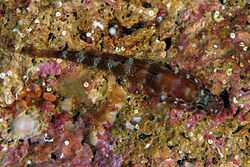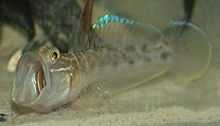Gobiinae
| Gobiinae | |
|---|---|
 | |
| Didogobius schlieweni | |
| Scientific classification | |
| Kingdom: | Animalia |
| Phylum: | Chordata |
| Superclass: | Osteichthyes |
| Class: | Actinopterygii |
| Subclass: | Neopterygii |
| Infraclass: | Teleostei |
| Superorder: | Acanthopterygii |
| Order: | Perciformes |
| Suborder: | Gobioidei |
| Family: | Gobiidae |
| Subfamily: | Gobiinae Cuvier, 1816 |
| Diversity | |
| About 150 genera | |
Gobiinae, the true gobies, are a subfamily of the goby family (Gobiidae). They are found in all oceans and a few rivers and lakes, but most live in warm waters. Altogether, the Gobiinae unite almost 2000 described species in 150 genera, and new ones are still being discovered in numbers.
Description and ecology
They are usually mid-sized to small ray-finned fishes; some are very colorful, while others are cryptic. Most true gobies are less than 10 cm (4 in) long when fully grown. The largest species (tank goby, Glossogobius giuris) can reach up to 50 cm (20 in); the smallest known species as of 2010, Trimmatom nanus, is just about one cm (half an inch) in length when fully grown, making it one of the smallest vertebrates.
In many true gobies, the pelvic fins have grown together into a suction cup they can use to hold on to substrate. Most have two dorsal fins, the first made up from spiny fin rays, while the other has some spines in the front followed by numerous soft rays.
They are most plentiful in the tropical and subtropical regions, but as a group are almost cosmopolitan in marine ecosystems. A few species tolerate brackish water, and some – Padogobius and Pomatoschistus species – even inhabit freshwater. They are generally benthic as adults (the spawn can distribute widely by ocean currents), only the bearded goby (Sufflogobius bibarbatus) is noted to be quite pelagic throughout its life. Most inhabit some sort of burrow or crevice and are somewhat territorial. In some cases, they live in symbioses with unrelated animals, such as crustaceans.
The larger species are fished for food, in some cases on a commercial scale. Many Gobiinae species are popular aquarium fish. Especially popular are the colorful species, some of which are regularly traded. In general, the interesting behavior and bold habits make most true gobies seem attractive pets. However, their territoriality and because even the smallest species are fundamentally carnivorous and need living food to thrive make them not easy to keep (particularly compared to the related sleeper gobies family Eleotridae). As typical for oceanic fishes, many Gobiinae tend to be almost impossible to breed in captivity, and some species have become rare from habitat destruction and overfishing.
Genera



.jpg)

.jpg)
- Acentrogobius – Malagasy mountain mullet
- Afurcagobius
- Akko
- Amblyeleotris – shrimp gobies, prawn gobies
- Amblygobius
- Amoya
- Ancistrogobius
- Aphia – transparent goby
- Arcygobius
- Arenigobius
- Aruma
- Asra
- Asterropteryx
- Aulopareia
- Austrolethops
- Barbulifer
- Barbuligobius
- Bathygobius
- Bollmannia
- Bryaninops – sea whip gobies
- Buenia
- Cabillus
- Caffrogobius
- Callogobius
- Chriolepis
- Chromogobius
- Corcyrogobius
- Coryogalops
- Coryphopterus
- Cristatogobius
- Croilia – burrowing goby
- Cryptocentroides
- Cryptocentrus – watchman gobies, "shrimp gobies", "prawn gobies"
- Cryptocentrus cinctus – yellow watchman goby
- Cryptocentrus pavoninoides – blue-spotted watchman goby
- Crystallogobius
- Ctenogobiops
- Deltentosteus
- Didogobius
- Discordipinna
- Drombus
- Ebomegobius
- Echinogobius
- Economidichthys
- Egglestonichthys
- Ego
- Elacatinus – neon gobies (including Gobiosoma)
- Eleotrica
- Enypnias
- Evermannia
- Evermannichthys
- Eviota – pygmy gobies, fringefin gobies
- Exyrias
- Favonigobius – "sand gobies" (including Papillogobius)
- Feia
- Fusigobius
- Gammogobius – Steinitz's goby
- Ginsburgellus
- Gladiogobius
- Glossogobius
- Gobiodon – coral gobies, "clown gobies"
- Gobiopsis
- Gobiosoma - naked goby
- Gobiosoma multifasciatum – green-banded goby
- Gobius – typical gobies
- Gobiusculus – spotted goby
- Gobulus
- Gorogobius
- Grallenia
- Gymneleotris
- Hazeus
- Hetereleotris
- Heterogobius
- Heteroplopomus
- Hyrcanogobius
- Istigobius
- Kelloggella
- Knipowitschia – dwarf gobies, spring gobies
- Larsonella
- Lebetus
- Lesueurigobius
- Lesueurigobius friesii
- Lobulogobius
- Lophiogobius
- Lophogobius
- Lotilia
- Lubricogobius
- Luposicya
- Lythrypnus
- Macrodontogobius
- Mahidolia (including Redigobius)
- Mahidolia mystacina – flagfin prawn goby
- Mangarinus
- Mauligobius
- Microgobius
- Millerigobius – large-headed goby
- Myersina
- Nematogobius
- Nes
- Nesogobius
- Obliquogobius
- Odondebuenia – coralline goby
- Ophiogobius
- Oplopomops
- Oplopomus
- Opua
- Padogobius
- Palatogobius
- Palutrus
- Parachaeturichthys
- Paragobiodon
- Paratrimma
- Pariah
- Parkraemeria
- Parrella
- Phoxacromion
- Phyllogobius
- Platygobiopsis
- Pleurosicya
- Polyspondylogobius
- Pomatoschistus
- Porogobius
- Priolepis
- Psammogobius
- Pseudaphya
- Psilogobius
- Psilotris
- Pycnomma
- Rhinogobiops – blackeye goby
- Risor
- Robinsichthys
- Signigobius – crab-eyed goby
- Silhouettea
- Siphonogobius
- Speleogobius
- Stonogobiops
- Stonogobiops dracula
- Stonogobiops nematodes – black-ray goby
- Stonogobiops yasha
- Sueviota
- Sufflogobius – bearded goby / pelagic goby
- Tasmanogobius
- Thorogobius
- Tomiyamichthys (including Flabelligobius)
- Trimma
- Trimma cana – red-striped goby
- Trimmatom
- Tryssogobius
- Valenciennea – hover gobies, "sleeper gobies"
- Vanderhorstia
- Vanneaugobius (formerly in Odondebuenia)
- Varicus
- Vomerogobius
- Wheelerigobius
- Wheelerigobius wirtzi – Cameroon goby
- Yongeichthys
- Zebrus
- Zosterisessor – grass goby